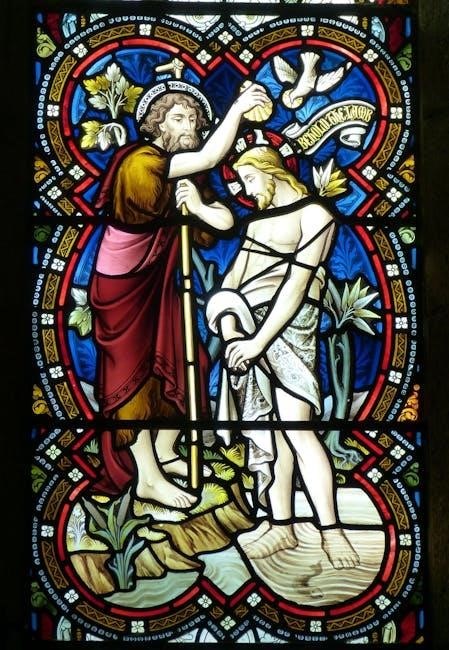The Gospel of John provides a unique and profound perspective on the life, ministry, and divinity of Jesus Christ. It emphasizes His pre-existence, miracles, and teachings, offering deep theological insights. Available in PDF formats, this Gospel is a vital resource for spiritual growth and biblical study.
Overview of the Gospel
Significance of the Gospel in Christian Scripture
The Gospel of John holds a central place in Christian Scripture, offering a unique witness to Jesus’ divinity and humanity. It provides compelling evidence for His divine nature through miracles and teachings, such as the resurrection of Lazarus and the “I Am” statements. John’s Gospel is often called the “Evangelistic Gospel” because it clearly presents Jesus as the Son of God and the means of salvation. Its themes of light, love, and eternal life resonate deeply with believers. The availability of the Gospel in PDF formats ensures its timeless message reaches modern readers.

Historical Background of the Gospel of John
The Gospel of John is traditionally attributed to John, one of Jesus’ original disciples, who is believed to have written it from Ephesus around 90-110 AD.
The Authorship of the Gospel
The Gospel of John is traditionally attributed to John, one of Jesus’ original twelve disciples, who is often referred to as “the disciple whom Jesus loved.” The authorship is supported by early church traditions and internal evidence within the text. While some modern scholars debate this, the majority of Christians accept John as the author. He is believed to have written the Gospel from Ephesus during his later years, drawing from his unique relationship with Jesus. This text is a cornerstone of Christian theology, emphasizing Jesus’ divinity and offering profound spiritual insights.
Date and Place of Writing
The Gospel of John is believed to have been written in the late 1st century, likely between 90-100 AD. Tradition suggests it was authored during John’s later years in Ephesus, where he is thought to have ministered. The exact location is not explicitly stated in the text, but early church traditions and internal evidence point to Asia Minor as the probable setting. This period allowed John to reflect on his experiences and provide a mature, theological account of Jesus’ life and teachings.
John’s Role as a Disciple and Witness
John, often referred to as the “beloved disciple,” was a close companion of Jesus and an eyewitness to His ministry, death, and resurrection. He is traditionally identified as the author of the Gospel, which underscores his unique perspective and intimate relationship with Christ. John’s testimony is rooted in personal experience, making his account deeply personal and authoritative. His writings emphasize Jesus’ divine nature and the transformative power of faith, offering readers a compelling narrative of salvation.

Structural Overview of the Gospel of John
The Gospel of John is organized into 21 chapters, beginning with a prologue, followed by Jesus’ public ministry, private discourses to His disciples, and concluding with His death, resurrection, and post-resurrection appearances, emphasizing His divine identity and mission.
Key Sections and Chapters
The Gospel of John is divided into 21 chapters, each highlighting pivotal moments in Jesus’ ministry. Key sections include the prologue (John 1:1-18), which introduces Jesus as the Word, and John 3, emphasizing spiritual rebirth. The feeding of the 5,000 (John 6) and the resurrection of Lazarus (John 11) showcase Jesus’ divine power. Chapters 13-17 focus on Jesus’ final teachings to His disciples, while John 20-21 describe His resurrection and post-resurrection appearances, confirming His identity as the Son of God. These chapters provide a rich theological foundation.
Main Themes and Emphases
The Gospel of John emphasizes the divinity of Jesus Christ, portraying Him as the eternal Word and the source of life. Central themes include God’s love, the necessity of spiritual rebirth, and the gift of eternal life through faith in Jesus. The Gospel also highlights the contrast between light and darkness, symbolizing spiritual truth versus worldly ignorance. Jesus’ miracles, known as “signs,” reinforce His divine authority and mission. These themes are woven throughout the narrative, offering profound theological depth.

Unique Characteristics of the Gospel of John
The Gospel of John uniquely emphasizes Jesus’ divinity, using symbolic language and “I Am” statements. It focuses on theological themes like light, darkness, and eternal life, distinguishing it from other Gospels.

Differences from the Synoptic Gospels
The Gospel of John differs significantly from Matthew, Mark, and Luke. It focuses more on theological themes like Jesus’ divinity and includes unique events such as the wedding at Cana and Lazarus’ resurrection. Unlike the Synoptics, John omits parables and emphasizes symbolic language, like “I Am” statements. The structure is distinct, with extended discourses and a focus on Jesus’ final days. These differences highlight John’s unique perspective on Jesus’ ministry and divine nature.
Emphasis on the Divinity of Jesus Christ
The Gospel of John distinctly highlights Jesus’ divinity, presenting Him as the eternal Word who is one with God. Through statements like “I and the Father are one” (John 10:30) and “Before Abraham was, I am” (John 8:58), Jesus affirms His divine nature. This emphasis is central to John’s purpose, as stated in John 20:31, to help believers recognize and trust in Jesus as the Son of God. This theological focus sets John apart from the Synoptic Gospels.

Key Events in the Gospel of John
The Gospel of John highlights transformative events like the Wedding at Cana, the feeding of the 5,000, and the resurrection of Lazarus, showcasing Jesus’ divine authority.
The Wedding at Cana and the First Miracle
The Wedding at Cana, recorded in John 2:1-11, marks Jesus’ first public miracle, transforming water into wine. This event, at the request of Mary, revealed His divine glory, leading the disciples to believe in Him. The miracle not only demonstrated Jesus’ power but also symbolized the abundance of grace He offers. This story is uniquely detailed in John’s Gospel, emphasizing faith and the manifestation of Jesus’ divine nature. PDF versions of this passage are widely available for deeper study.
The Feeding of the 5,000 and the Bread of Life Discourse
In John 6:1-14, Jesus feeds 5,000 people with five loaves and two fish, showcasing His divine power and compassion. This miracle leads to the Bread of Life Discourse (John 6:25-59), where Jesus declares Himself the spiritual bread sustaining eternal life. His teachings emphasize faith and unity with God, highlighting His divine nature. This event is a cornerstone of John’s narrative, illustrating Jesus’ role as the ultimate source of spiritual nourishment and salvation. PDF resources provide deeper insights into this pivotal moment.
The Resurrection of Lazarus and Jesus’ Final Days
In John 11:1-44, Jesus resurrects Lazarus, demonstrating His power over death and further revealing His divinity. This miracle intensifies the Pharisees’ opposition, leading them to plot His death (John 11:45-57). Jesus’ final days culminate in His triumphal entry into Jerusalem (John 12:12-19) and heartfelt teachings to His disciples, emphasizing love and eternal life. The resurrection of Lazarus serves as a pivotal moment, showcasing Jesus’ authority and preparing for His ultimate sacrifice. PDF studies explore these events deeply.

Theological Themes in the Gospel of John
The Gospel of John explores profound theological themes, including the pre-existence and divinity of Jesus, the concept of light vs. darkness, and the role of the Holy Spirit.
The Pre-Existence and Deity of Jesus Christ
The Gospel of John emphasizes Jesus’ pre-existence and divine nature, as seen in John 1:1-5, where Jesus is described as the eternal Word who was with God and is God. This theme is central to John’s Christology, highlighting Jesus’ unique relationship with the Father. Verses like John 10:30 and 20:28 further affirm His deity, establishing Him as equal to God. This theological foundation underscores Jesus’ role as the Son of God and the source of eternal life, making it a cornerstone of Christian belief.
The Concept of Light and Darkness
In John’s Gospel, light symbolizes God’s purity and truth, while darkness represents sin and separation from God. Jesus is described as the Light of the world (John 8:12), offering spiritual enlightenment. This contrast is central in verses like John 1:4-5 and 3:19-21, where light shines in darkness, yet darkness often prevails due to human preference for sin. The struggle between light and darkness underscores humanity’s spiritual condition and the need for redemption through Christ, emphasizing His role as the source of eternal light.
The Role of the Holy Spirit and Eternal Life
The Holy Spirit is a vital figure in John’s Gospel, often referred to as the “Helper” or “Advocate.” Jesus introduces the Holy Spirit in John 14:16-17, promising His presence to believers. The Spirit convicts the world of sin, righteousness, and judgment (John 16:8-11). Eternal life is a recurring theme, offered through belief in Jesus (John 3:16), and the Spirit’s role in regeneration is highlighted, emphasizing the divine gift of eternal life through faith and the indwelling of the Holy Spirit.

Practical Applications of the Gospel of John
The Gospel of John emphasizes divine love, spiritual rebirth, and the command to love others. It encourages believers to walk in truth, abide in Christ, and trust God’s plan, offering eternal life through faith in Jesus.
The “Born Again” Concept and Spiritual Renewal
The “born again” concept, central to John’s Gospel, signifies spiritual renewal through faith in Jesus Christ. This transformative experience, rooted in divine love, enables believers to transcend earthly limitations and inherit eternal life. The PDF versions of John’s Gospel provide in-depth studies of this doctrine, emphasizing its practical implications for personal salvation and a life lived in accordance with God’s will. This teaching remains foundational for Christian spirituality and discipleship.
The Commandment to Love One Another
Jesus’ commandment to love one another, as recorded in John’s Gospel, is a cornerstone of Christian ethics. This mandate, rooted in God’s love for humanity, calls believers to demonstrate selfless compassion and unity. PDF resources on John’s Gospel explore this theme, highlighting its practical application in fostering community and reflecting Christ’s character. By loving one another, believers fulfill Jesus’ desire for unity among His followers, embodying the essence of His teachings. This command remains central to living out the Gospel.

Resources for Studying the Gospel of John
The Gospel of John is widely available in PDF formats, including study guides, sermon outlines, and commentaries. These resources provide in-depth analysis and practical applications.
PDF Versions and Study Guides
The Gospel of John is accessible in various PDF versions, including the King James Version and New Jerusalem Bible. Study guides like sermon outlines by Mark A. Copeland and verse-by-verse expositions are available for deeper analysis. Reformation Trust offers a free eBook on John, while resources from AW Pink and Crosswire Bible Society provide additional insights. These tools are ideal for personal study, classrooms, and homeschooling, offering notes sections for reflection and comprehension.
Commentaries and Expositional Materials
Commentaries on the Gospel of John offer in-depth insights into its theological themes and historical context. R.C. Sproul’s commentary, available as a free eBook, explores the divinity of Christ. Verse-by-verse expositions by AW Pink and Mark A. Copeland provide detailed analysis, while resources from the Crosswire Bible Society and eBible.org support comprehensive study. These materials are invaluable for understanding John’s unique perspective on Jesus’ ministry and teachings, enhancing both personal and scholarly engagement with the text.
Online Tools and Bible Study Aids
Online tools like BibleGateway and eBible.org provide accessible PDF versions and study aids for the Gospel of John. Platforms offer verse-by-verse analysis, historical context, and theological insights, aiding deeper understanding. These resources are ideal for personal study, sermon preparation, and classroom use, making comprehensive exploration of John’s Gospel convenient and enriching for learners of all levels.
The Gospel of John offers profound insights into Jesus’ divinity and mission, making it a cornerstone of Christian faith. Available in PDF resources, it continues to inspire spiritual growth and reflection.
Final Thoughts on the Gospel of John
The Gospel of John uniquely emphasizes Jesus’ divine nature and mission, offering deep theological insights. Available in PDF formats, it serves as a vital resource for spiritual growth. Its teachings on love, light, and eternal life continue to inspire believers, making it a foundational text for understanding Christ’s identity and purpose. This Gospel remains a timeless guide for those seeking a deeper connection with God.
Encouragement to Deepen Study and Reflection
Take time to deeply engage with the Gospel of John, exploring its rich theological themes and spiritual truths. Utilize PDF resources and study guides to enhance your understanding. Reflect on Jesus’ teachings, miracles, and divine nature to strengthen your faith. Let this Gospel inspire personal growth, fostering a deeper relationship with Christ and a greater appreciation for His love and sacrifice.

